|
|
|
Bob
Hayes Dalek Horn
Back Loaded Horn for Fostex
FE166
|
|
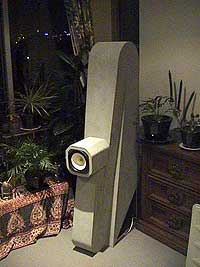
|
18_february_07
The Dalek speaker
design was conceived because of my need for efficient loudspeakers to be powered
from my DIY Single Ended Triode amplifier which only provides around 3W RMS per channel.
Plans |
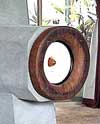 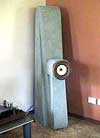 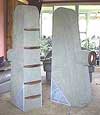 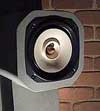 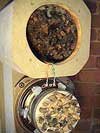 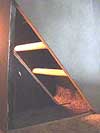
|
| |
|
High efficiency and an
easy to drive speaker impedance where my criteria, so I looked for full range drivers,
to avoid crossover circuitry. Fostex FE series drivers are excellent value, well
built and are highly efficient due to their powerful magnet assembly.
The FE206E was my first choice, but I rejected it for this project because of the
rising frequency response in the upper midrange and treble, and I wanted to use no
compensation circuitry.
For a trade off in efficiency, the FE166E offers some benefits... Flatter overall
response and less moving mass.
Studying several proven designs, I decided to build something unique. Using an online
java applet www.ishtek.com.au (dead link) I modeled the Fostex recommended enclosure,
and compared the applet results to the Fostex data. I was sure I could squeeze more
bass extension from the driver, so I designed a longer horn. The added bonus of a
longer horn is the tightening of the comb filter effect spikes (resulting from using
an undersized mouth), so I reckoned I could use a smoother profile horn than the
Fostex design, which has many square folds. I don't much like the aesthetics of the
Fostex enclosure either.
A smaller chamber is used on the Dalek than many designs to control cone motion.
The FE166E has a limited xmax (0.6mm), so in many enclosures, it will reach the limit
of linear excursion early. The drawback of the smaller throat is that more mid bass
frequencies will be loaded by the horn, where horn loading is not required. The result
is a 'bump' in the midbass.
Looking at the Fostex enclosure again, there is actually a 'hole' in the response,
and then some peaking, so I didn't expect a flat response. For that I could build
lifeless over complex 'monitors', and use an amp made from 'sand'!
Placing the mouth at the rear of the cabinets, and venting from the sides, means
the room corner and cabinet sides can be used to extend the effective horn length
and mouth size, resulting in smoother response and deeper bass. I conservatively
estimate the corner loading brings the effective length to well over a half wavelength
of the FE166E's resonant frequency.
If corner placement is not practical, wall placement will have a similar effect,
only to a lesser degree. |
| |
|
|
| To keep the footprint
to a reasonable size, I decided to make the speakers tall, as even with an ordinary
enclosure, it would be dead space above. The result of the mouth placement, smooth
folds and smaller footprint lead to the overall appearance of the Dalek. |
| |
|
|
|
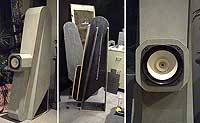
|
Personal impressions:
Nothing is perfect, and Horn speaker design is all about juggling with compromise,
but I think the overall presentation of the Daleks is excellent. Yes, there is a
peak in the midbass, which can be smoothed with fibrous wadding in the chamber and
horn throat. I used BBC speech to tune them, but the WAF told me to pull out the
wadding because Tool's album 'Lateralus' lost all it's drive and impact. |
| |
|
|
I compromised by only
lining the walls and magnet with silicone and pebbles, and adding a single thickness
of 1/4" felt. We can both live with that.
In our previous home, a city apartment, where there where neighbours on all sides,
up and down, the Daleks gave a useful bass boost, like 'loudness compensation', at
lower listening levels. It was when we moved to a detached house in the sticks, and
our 'normal' listening level increased substantially, that the bass output became
excessive.
To combat this problem, I installed sand filled fabric 'cones' from the horn throat
down into the first section of the horn expansion. This modification proved successful,
and I would recommend this method of 'tuning' the Daleks. The cone should be sized
depending on the room acoustics, type of amplifier, preferred listening levels and
personal tastes. I settled for 60mm diameter at the top (throat) tapered to zero
at the first horn fold. The consequential reduction in throat size effectively reduces
horn efficiency, with a slight (theoretically at least) broadening of the horns effective
bandwidth while maintaining correct flare. The Sd/St ratio
with a 60mm cone installed is 2.28, as opposed to the original 1.54. |
| |
|
|
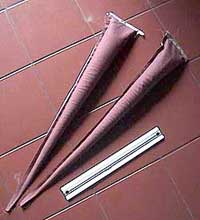 |
If a constructor didn't
want the hassle of tuning them, they could simply build this modification into their
speakers by reducing the throat width from 120mm (internal), to 80mm. The side panels
would require a little more 'twist', and the lower front panel would need to be modified
but the remainder of the cabinet remains the same. The chamber assembly would also
be easier to install.
<< fillets/carrots used to tune throat |
| |
|
|
I won't bother babbling
on about 'impact' and 'dynamics' as I reckon it comes with the territory of horn
speakers. When I'm being over critical about the sound, plugging in the old bass
reflex speakers soon puts me straight! Impact and definition are the most impressive
qualities, probably due to the excellent drivers, planet_10 phase plugs and horn loading. Poorly recorded
music is quite noticeable through these speakers, as I can clearly hear distortion
on some albums (notably sampled material), where I never before noticed it.
Feel free to build your own Daleks.
Bob. |
|
|
|
|
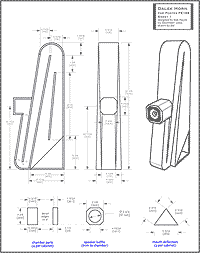
Enclosure Plans [188 kB pdf]
(note: these
do not yet reflect the new throat options mentioned in the text
|
Modeled
FR curves & measured impedance
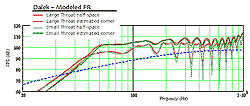

|
| |
|
|